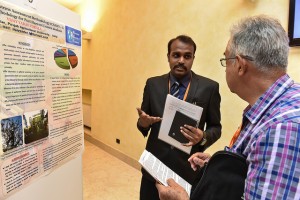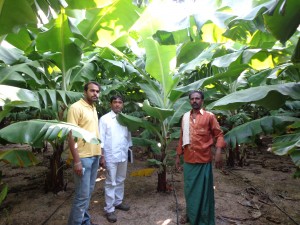By Vijay Yadav Tokala, Ph.D. Student, Punjab Agricultural University, India

Vijay Tokala presents at the poster session on Day 1 of the congress. / © Francesco Vignali Photography
This post is part of the ADM Institute’s #PreventPHL blog campaign, following up on the First International Congress on Postharvest Loss Prevention. To read more posts in the series, click here.
It was a wonderful experience to take part in the First International Congress for Postharvest Loss Prevention organized at one of the beautiful cities in the world. I am grateful to ADM Institute for providing full sponsorship to attend this congress, which gave me a good chance to interact with experts, researchers, philanthropists and different people from more than 60 countries regarding several issues and activities related to food loss all over the world. Every session was informative and the best part was the roadmap session, which gave an opportunity to every participant to share their ideas and views towards the reduction of postharvest losses.
With the issue of global food security emerging as an important societal concern, several methods are being implemented to increase the production of crops, but already many of these researchers are about to reach saturation stage in many crops in coming future. Indeed, many studies have revealed that postharvest losses are substantial, with a commonly cited assessment that 1/3 of the world’s agricultural produce by weight is wasted and 1 out of every 4 calories of food produced isn’t reaching the consumer. Being more specific, higher postharvest losses are observed in cases of fruits and vegetables, which are more perishable than food grains. Prevention of these postharvest losses is increasingly being cited as a means to ensure world food security by several international and national bodies, including pioneer organizations like FAO. By developing a strategy to reduce these losses, we would be able to save lots of food, which could feed a huge hungry population of the world. But to develop an appropriate strategy, there exists an immediate need to find out the major factors causing postharvest losses and measure the losses, either on the basis of weight or nutrition. By measuring the postharvest losses caused by different factors, we will be able to prioritize the area of concentration before acting upon those factors to reduce losses. Right now, there is still need to standardize appropriate methods to measure postharvest losses.
 I was introduced to the concept of Commodity Systems Assessment Methodology (CSAM) by Dr. Lisa Kitinoja, founder of the Postharvest Education Foundation, during an e-learning course. I have implemented this methodology at different locations in India and after analysis it was found that lack of suitable packaging, lack of ideal transport facilities and unavailability of appropriate storage facilities were major factors causing postharvest losses. CSAM was originally developed by Jerry La Gra (1990) for facilitating professionals in the agriculture sector for identifying and solving problems throughout the commodity system through a systematic approach, from planning to product distribution. The method helps to ensure that all factors affecting a given commodity are considered in development programs, whether related to pre-production, production, harvest, postharvest, or marketing.
I was introduced to the concept of Commodity Systems Assessment Methodology (CSAM) by Dr. Lisa Kitinoja, founder of the Postharvest Education Foundation, during an e-learning course. I have implemented this methodology at different locations in India and after analysis it was found that lack of suitable packaging, lack of ideal transport facilities and unavailability of appropriate storage facilities were major factors causing postharvest losses. CSAM was originally developed by Jerry La Gra (1990) for facilitating professionals in the agriculture sector for identifying and solving problems throughout the commodity system through a systematic approach, from planning to product distribution. The method helps to ensure that all factors affecting a given commodity are considered in development programs, whether related to pre-production, production, harvest, postharvest, or marketing.
This methodology includes a utility-specific questionnaire with a set of questions related to different aspects viz., governmental policies, facilitating services, farmer’s general cultivation practices, harvesting methods, packaging facilities, storage, and marketing. It needs an inter-disciplinary approach and mostly includes a team of people working together to go through the available data and also gather information by interviewing the local growers, handlers, traders and marketers of the commodity. The data collected is then thoroughly analyzed and then utilized for identification of sources of postharvest losses and then they are prioritized in terms of importance (by quantity or valuation of losses). By prioritizing the factors, one can easily judge the immediate necessary action and also which area is to be focused for best results of the action. CSAM can be widely used to conduct postharvest losses analysis of different crops, to know the reasons for loss, the extent of loss (both physically and financially), and to act appropriately after suitable prioritization in order to overcome the losses.
The blog entries in this #PreventPHL series are by students and members of the PHL Prevention community of practice. The opinions expressed are those of the individual authors and do not necessarily reflect the position of the ADM Institute. In addition, none of the statements should be considered an endorsement of any person, product, or technique by the ADM Institute.


Thank you Vijay Yadav Tokala, Punjab Agricultural University, India for the post discussing standard methodology for measuring PHL.
Several international and national bodies, including pioneer organizations know that net calories accomplish the physical labor needed to grow and harvest increased production.
Interdisciplinary approaches and utility specific methodology are delivering sms texting, commodity exchanges, microfinance, mechanization, improved seed, fertilizer and pest management. However, Dr Cardwell (2015) presents
“Farmers whose scale of operation is too small to be able to produce SAFE FOOD, are too small to farm maize (or any aflatoxin sensitive staple).”
Even though the aflatoxin factor is hard to measure, aflatoxin is likely causing more PHL than 1 out of every 4 calories and thus limiting SSA growers and grain exports, needlessly.
Fruits and vegetables are very perishable, lack net calories and that means relatively
“Tackling [dry staple grain] post-harvest loss is not rocket science. It does not require technological breakthroughs or years of high level scientific research as do some of the other challenges we face” (Etharen Cousins, 2013 Executive Director of the UN WFP).
Experts from all over the world, working on a myriad of projects spotlighted “Deliver moisture testing to growers” because practical testing will overcome PHL at various stages of the value chain. Delivering moisture standards above protocol (Lanier, 2015) at different levels of public governance means more quality calories reach growers and staple grain exports improve global food security soon… so fruits and vegetables have meaning later.
Thank you ADMI for the chance to comment,
William Lanier
References:
Cardwell, K. (2015, April). Aflatoxin Identifying the Way Forward [TOPS Presentation].
Retrieved .
Cousin, E. (2013). Improving global food security without rocket science [Global Food Security Analysis].
Retrieved .
Lanier (2015) (ADM Institute Post) retrieved at: .